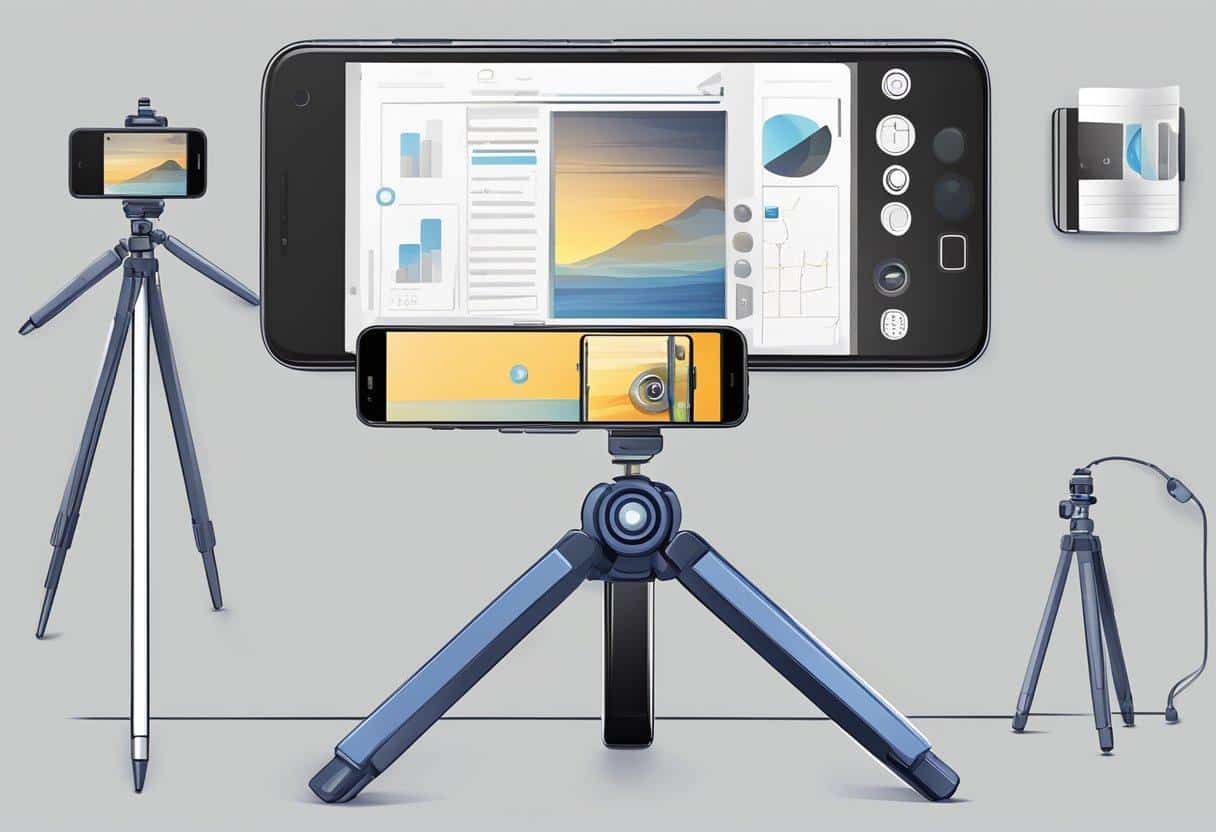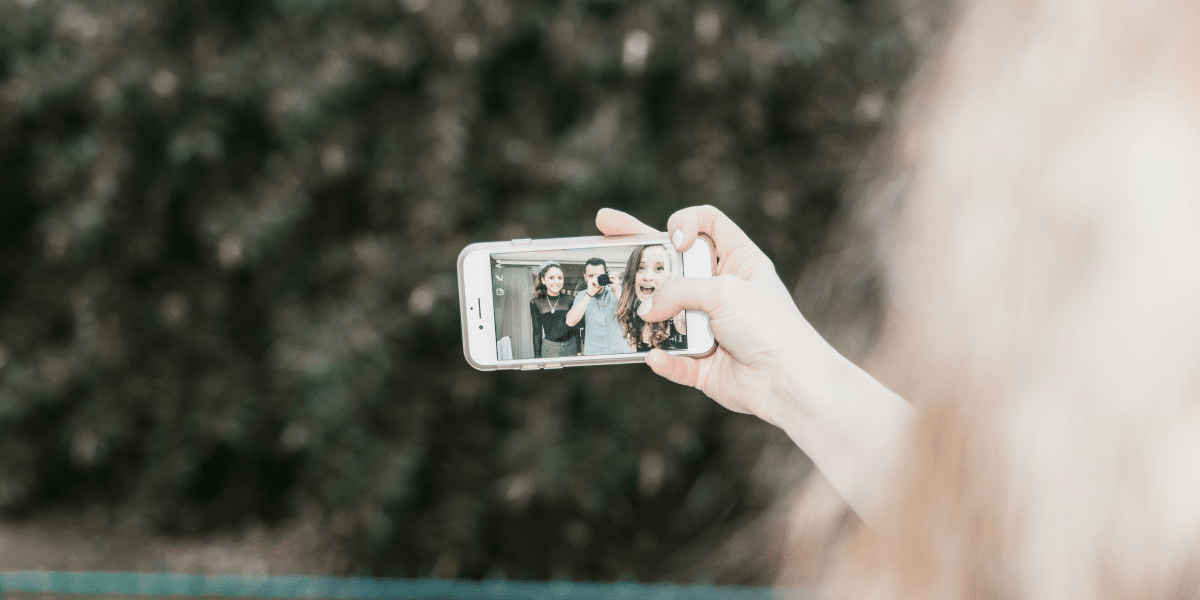Understanding the Basics of Selfie Photography
Before we delve into the intricate balance of technology and creativity that makes a selfie stand out, let’s grasp the foundational elements that contribute to capturing a great selfie.
The Science and Art of Selfie Photography
Taking a selfie is both a technical and artistic endeavor. Selfies aren’t just casual photos; they are a way we express our identity and mood in a single shot.
Camera Lens and Settings: The lens of your camera plays a crucial role in the quality of your selfies. Using your phone’s front camera is recommended since it allows you to see the frame as you capture it.
Modern smartphones often include a wide-angle lens on the front camera, which can create a dynamic perspective. However, be mindful of adjusting your position to avoid distortion.
Lighting: Good lighting is imperative. Natural light is the best source, offering a soft and even look.
Aim for times when the light is diffused, like during the golden hour just after sunrise or before sunset.
Angles: Find your “good side” and work with angles that emphasize your features. Holding your phone above eye level and tilting it slightly downwards can result in a more flattering and slimmer look.
Advanced Camera Features: Familiarize yourself with advanced features like portrait mode or HDR, which can enhance the focus on you and correctly expose the photo even in mixed lighting conditions.
Editing: After taking a selfie, editing can enhance it subtly. For example, Facetuneapp.com is renowned for the magic it can work on a selfie, allowing for subtle retouching that maintains your natural look.
How to take Great SELF PORTRAITS – Advanced Selfie Photography Tutorial
Mastering Lighting for the Perfect Selfie
Lighting is a crucial ingredient in our quest for the perfect selfie. Let’s examine how we can use natural and artificial light sources to our advantage.
Utilizing Natural Light and Artificial Light
Natural Light:
The golden hour, which is shortly after sunrise or before sunset, provides a soft, diffused light that is very flattering. When indoors, stand near a window to benefit from natural lighting. Ensure the light is facing you to illuminate your features evenly.
Artificial Light:
Use a ring light to provide even lighting that minimizes shadows. They help create a professional look even in the most ordinary settings. Avoid using your camera’s flash, as it can be harsh and unflattering. Instead, opt for adjustable LED lights or softboxes.
Overcoming Harsh Shadows and Highlights
Shadows:
Position yourself so light falls directly onto your face, thus avoiding harsh shadows. If you’re using a single source of light, a reflector can bounce light back onto darker areas. For outdoor selfies, avoid direct sunlight, especially around midday. If unavoidable, seek open shade, such as under a tree, where the light is more even.
Highlights:
Be mindful of overly bright spots in your selfie. They can distract from your face and make the photo look overexposed. If using photo editing tools like facetuneapp.com, you can tone down highlights and brighten up shadows for a balanced look.
Finding Your Best Angles for Flattering Selfies

When taking selfies, finding the right angle is like discovering our best side in front of a mirror; it showcases our features in the most flattering way and gives the portrait a sense of depth.
The Importance of Camera Angle and Position
The camera angle plays a critical role in the aesthetics of our selfie. A high angle, with the camera slightly above eye level, can help to sharpen the chin and bring a youthful vibrancy to our face. On the other hand, a straight-on or lower angle tends to broaden our features and is less commonly used for a flattering effect.
High angle: Hold your camera slightly above your head and look up towards the lens to ensure your eyes are focused.
Straight on: Keep the camera at eye level for a straightforward, honest shot.
Low angle: Use sparingly, as it can distort features and is generally less flattering.
Experimenting With Different Perspectives
To determine the most appealing perspective, we must experiment with different angles and consider the rule of thirds. This composition guide suggests dividing the frame into a grid and aligning our features along these lines or intersections. In doing so, we strike a balance that’s pleasing to the eye and can make our selfies stand out.
Rule of thirds: Align your eyes with the top grid line for an aligned, balanced shot.
Cropping: Try not to crop out parts of your head; leave some space above to avoid a cramped look.
Angles to avoid: Generally, avoid shooting from directly below the chin unless aiming for a specific creative effect.
Setting the Scene for Authentic Selfies

Before we dive into the intricate details, let’s remember that an authentic selfie captures the essence of the moment and reflects our genuine emotions. Choosing the right background and knowing how to express ourselves can transform a simple selfie into something truly memorable.
Choosing the Right Background and Composition
When we’re taking a selfie, the background is just as important as our expression. A cluttered or distracting background can take the focus away from us, while a fitting backdrop can complement and enhance our selfie.
Here’s how to nail it:
Simplicity is key: Look for a background that isn’t too busy. A solid-colored wall or a scene that doesn’t steal the spotlight works best.
Relevancy: Choose a background that is relevant to the story we’re telling. It could be as simple as our living room if we aim for a cozy vibe.
Composition: Follow the rule of thirds — position ourselves slightly off-center to create a well-balanced photo and avoid dead center to add a touch of dynamism.
Profile Picture Perfection: For a profile picture, ensure the background resonates with the image we want to project. Professional settings work well for LinkedIn, while more casual settings suit social apps.
Incorporating Mood and Emotion
A selfie without emotion falls flat. That’s why it’s essential to convey the right mood.
Here are some tips to express true emotion:
Let it come naturally: A genuine smile or a spontaneous reaction will always look more authentic than a forced one. Let’s try to think of something happy or funny for a natural smile.
Set the mood: Use props or specific settings to reflect our current state. For example, sunglasses for a sunny day or a scarf for a chilly outing can add to the storytelling.
Confidence shines through: A confident posture and self-assured expression will make the selfie stand out. Stand or sit tall, keep our chin up, and let our self-confidence take the lead.
Facial expressions: Practice different expressions in the mirror to find what looks most genuine and confident. Remember, a real smile also reaches our eyes.
Utilizing Advanced Technical Features

In our quest for perfect selfies, we must harness the power of advanced technical features available on smartphones and dedicated photo editing apps. Let’s dig into how to maximize camera settings and utilize popular photo editing apps for impeccable selfies.
Maximizing Camera Settings and Photo Editing Apps
Camera Settings:
Resolution and Quality: Always set your camera resolution to the highest quality to ensure detailed images. Look for HDR (High Dynamic Range) mode, which combines multiple shots at different exposures for the best picture.
Filters and Enhancements: Before taking a selfie, experiment with live filters available on your smartphone. Post-capture, use advanced editing tools to fine-tune your pictures.
Photo Editing Apps:
Editing and Post-Processing: Apps such as Facetune App elevate your selfie game by providing robust editing tools. With such apps, you can adjust brightness, contrast, and saturation, remove blemishes, and even alter the shape of facial features if desired.
Creative Edits: Add flair to your selfies with overlays, text, and other artistic elements to make your photos stand out.
Leveraging Timer, Burst Mode, and Portrait Mode:
Timer: Using the timer gives you a few extra seconds to get into the perfect pose. Many cameras allow you to choose from a range of time intervals.
Burst Mode: Activate burst mode to take a rapid series of shots. It’s ideal for capturing the best moments in actions or selecting the most flattering photo from a multitude of images.
Portrait Mode: If your device supports it, use portrait mode to achieve a professional-looking depth of field. This mode blurs the background, making the subject — you — stand out sharply against a soft backdrop.
Exploring Creative Selfie Techniques
We all want to step up our selfie game, and being creative is key. Whether it’s by incorporating fun props or mastering the group selfie, we’ve got some specific tips to add that extra flair to your shots.
Playing With Props and Accessories for Unique Shots
To infuse personality and originality into our selfies, we consider adding props and photo accessories that reflect our style. Here’s how we can make these shots pop:
- Props: Grab items that tell a story about us, like a book for the avid reader or a guitar for the music lover. This adds context and interest to our self-portraits.
- Accessories: Simple additions like sunglasses or hats can dramatically change the vibe of a selfie from casual to chic.
Capturing Group Selfies and Mirror Selfies
When it comes to group selfies and mirror selfies, there’s a fine art to capturing everyone looking their best.
- Group Selfies: We use a selfie stick or tripod to get the shot from a distance, ensuring everyone’s in frame. Then, we take the shot, making sure to remember everyone’s best angle.
- Mirror Selfies: For this, standing at a slight angle with the phone at chest height delivers a good perspective. It’s about finding the right balance between casual posture and intentional styling.
Frequently Asked Questions
When it comes to capturing perfect selfies, we often find ourselves flooded with questions about lighting, angles, and editing. Here, we’ve gathered the most common queries and provided straightforward answers to help you level up your selfie game.
What are the best lighting techniques for taking a great selfie?
Natural lighting is your best friend for selfies. We recommend facing a window or going outside during golden hour, that time right after sunrise or before sunset, for a soft, warm glow. If indoors, a ring light can provide even, flattering illumination.
What angles are most flattering for selfies?
Experiment with angles by holding your phone a bit higher than your face to accentuate your features. Tilting your head slightly and finding your ‘good side’ can also make a selfie more engaging. Remember, the angle that captures your uniqueness is the most flattering.
Can you provide beginner-friendly tips for taking engaging selfies?
Sure! Start with a clean lens for a clear image. Then, use your phone’s grid feature to frame your face using the rule of thirds. Smile naturally, and try to relax your eyes to avoid the dreaded ‘camera stare’. Engaging selfies are those where we look comfortable and authentic.
What are some effective selfie poses that work for everyone?
Common go-to poses include the classic head tilt, the ‘thinking’ hand-on-chin, and the playful peace sign. We all have diverse personalities, so a pose that feels natural and aligns with our character often works best for everyone.
How can you enhance a selfie with creative edits using the app?
After taking your selfie, you can enhance it using apps like Instagram or Facetune, which is known for its robust editing features. Adjust brightness, contrast, and saturation, add filters, or even retouch specific features to add a professional touch to your selfies.
What are the steps to achieving a perfect selfie using your phone’s advanced features?
To achieve a perfect selfie, first ensure sufficient lighting.
Use portrait mode if available, to create a depth-of-field effect.
Play with your phone’s HDR or Live Photo options for a higher dynamic range or interesting live effects.
Lastly, edit your final shot with your favorite app features to polish your look.
Published by: Khy Talara

















